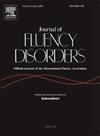双语口吃成人的亚词汇言语感知和注意网络:一项行为和电生理研究。
IF 2.1
3区 医学
Q1 AUDIOLOGY & SPEECH-LANGUAGE PATHOLOGY
引用次数: 0
摘要
目的:几项研究表明,口吃的成年人有听觉感知和注意力控制缺陷。此外,这些研究倾向于关注单语者,而口吃和双语者似乎都对这些过程有影响。本研究旨在(1)比较口吃和非口吃双语成人的亚词汇言语感知和非语言、非听觉注意网络;(2)探索第二语言熟练程度对这些过程的影响程度。方法:采用不注意(MMN)和注意听觉怪异范式(P300)对13名BAWS和13名ban进行电生理实验,其中包含音位对比(发音位置)。注意网络测试(ANT)作为注意控制的行为测量。结果:(1)MMN和P300效应的振幅和起效潜伏期在BAWS和ban之间没有差异,但BAWS不存在典型的标准音节和异常音节的区别。在行为上,BAWS表现出效率较低的警报网络和执行注意网络。(2)二语熟练程度对亚词汇语音感知无显著影响,但对执行注意有显著负相关。结论:这些结果表明BAWS在保持警觉状态、抑制无关信息和选择相关信息方面存在困难,而不是从感官输入中选择信息。在感觉加工方面,BAWS与ban相比表现出非典型模式,但在音素识别和分类方面没有差异,无论注意力不集中还是注意力倾听模式。最后,第二语言熟练程度影响结巴者的非语言、非听觉注意,强调需要对结巴者的双语特征进行更全面的研究。本文章由计算机程序翻译,如有差异,请以英文原文为准。
Sublexical speech perception and attention networks in bilingual adults who stutter: A behavioral and electrophysiological study
Purpose
Several studies show that adults who stutter have deficient auditory perception and attentional control. Moreover, these studies tend to focus on monolinguals, whereas both stuttering and bilingualism seem to have implications for these processes. This study aimed (1) to compare sublexical speech perception and nonlinguistic, nonauditory attention networks between bilingual adults who stutter (BAWS) and who do not stutter (BANS) and (2) to explore to which extent second language (L2) proficiency influences these processes.
Method
Thirteen BAWS and thirteen BANS were enrolled in an electrophysiological protocol using an inattentive (MMN) and an attentive auditory oddball paradigm (P300) containing a phonemic contrast (place of articulation). The Attention Network Test (ANT) was administered as a behavioral measure of attentional control.
Results
(1) The amplitude and onset latency of the MMN and P300 effect did not differ between BAWS and BANS, but BAWS did not show a typical differentiation between standard and deviant syllables as measured by the P2. Behaviorally, BAWS displayed a less efficient alerting network and executive attention network. (2) L2 proficiency had no significant effect on sublexical speech perception, but was negatively associated with executive attention in BAWS.
Conclusions
These results suggest that BAWS display difficulties in maintaining an alert state and inhibiting irrelevant and selecting relevant information, rather than selecting information from sensory input. In sensory processing, BAWS showed an atypical pattern compared to BANS, but no disparities in phoneme discrimination or categorization, regardless of an inattentive or attentive listening mode. Lastly, L2 proficiency influenced nonlinguistic, nonauditory attention in BAWS, emphasizing the need for more comprehensive research on bilingual profiles in people who stutter.
求助全文
通过发布文献求助,成功后即可免费获取论文全文。
去求助
来源期刊

Journal of Fluency Disorders
AUDIOLOGY & SPEECH-LANGUAGE PATHOLOGY-REHABILITATION
CiteScore
3.70
自引率
14.30%
发文量
23
审稿时长
>12 weeks
期刊介绍:
Journal of Fluency Disorders provides comprehensive coverage of clinical, experimental, and theoretical aspects of stuttering, including the latest remediation techniques. As the official journal of the International Fluency Association, the journal features full-length research and clinical reports; methodological, theoretical and philosophical articles; reviews; short communications and much more – all readily accessible and tailored to the needs of the professional.
 求助内容:
求助内容: 应助结果提醒方式:
应助结果提醒方式:


